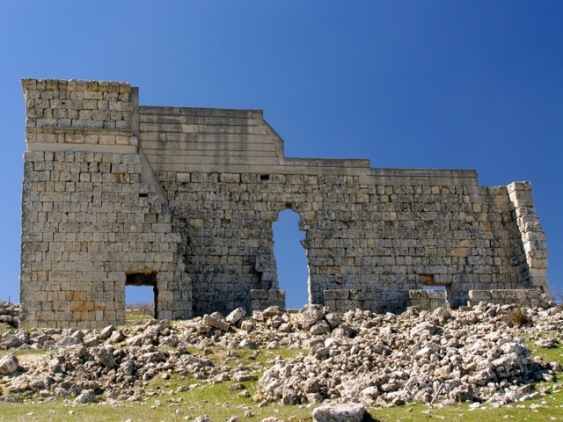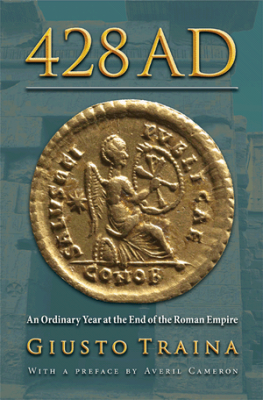
Giusto Traina, a professor at the University of Rouen, could have spent a decade more on his book about one year. 428 AD: An Ordinary Year at the End of the Roman Empire took Traina a few years to write, digging through scarce resources on the world inside and outside the Roman Empire. “Of course, it will be always more interesting and exciting to try to understand why Rome fell,” Traina said. “Maybe I could have explained why Rome was still there, despite all the strange events that were happening around it.” Instead, Traina’s book, scholarly but still reader-friendly, is a snapshot of the world in a fairly normal year. Below, Traina discusses the difficulty of studying a year not found on many timelines, and how the study of history can benefit from imagining a global world, even in the oldest of times.
 Q. How did you come to pick the year 428?
Q. How did you come to pick the year 428?
A. I teach ancient history, and this book is very general. It’s sort of a global study. But as a matter of fact my field is Armenian studies. In 2003 I was invited to a conference on Persia, and I was invited to give a paper on Armenian history and I chose to study the most important event of the Late Antiquity for Armenians, the end of the kingdom, which happened in 428.
So I decided, when doing this paper, to give myself an idea of this event. There is a methodological question: we know Armenia ended in 428, but we only have Armenian sources and not Roman, not Byzantine, not Arabic sources. I wondered, why? I decide to give them my perspective. I happened to talk about this matter with my publisher, who was actually asking me for a subject of a new book. I told him since I was working on this topic for the conference, I said it could be a nice idea to make a global study of the period, so why don’t we make a general history of the years 420 through 440.
Then he stopped me and said, “Why don’t you try to do a one-year book ?” I realized he was right, and I started the journey, which was a total intellectual journey, which brought me some serious evidence that I was aware of but only from a very scattered perspective. I was able to find completely new research. Everyone knows the wonderful books by Peter Brown on Late Antiquity, but these books always present a general view of a period of long duration, from the 3rd to the 6th centuries, which is actually a very fine way of studying Late Antiquity. So I thought why don’t I do [the one-year study]? I think the result was not that bad, thought that will depend on the readers. But I can say it was maybe the most wonderful experience of my career and research. I actually worked on it for about two to three years, and every time I went to my desk working on 428, I was delighted. I’m not sure I will be able to face such an experience again very soon. We’re also involved with works of erudition, you know? Maybe it was the first time I was really trying to do something reader-friendly.
Q. What happened in 428? Is it a significant year?
A. Only for the Armenians. It was the end of the kingdom of Armenia. But then I realized there were some other important dates. When you study the key dates, they’re 410, when the Goths sacked Rome, or 476, the official end of the Western Roman Empire. But in fact all these dates are all seldom epoch-making for the period itself. They can be symbolic for our consciousness of modern history, but otherwise, no. This sort of experiment could be brought up for almost any date in the world, and it would always bring something new. I’m not committed to this notion, I didn’t marry this perspective, but I’m not sure that a book on 476 could yield a more interesting study than 428. This is maybe sort of a novice attitude. When the Italian edition appeared, I offered copies to my colleagues, and I was always interested in looking at their puzzled faces. You know, you take a professor of Roman history, with a long experience of research, and he’s trying to rack his brain thinking what in the hell happened in 428.
 Q. You mention in the book that the concept of time had different meanings for rulers and ruled. Could you elaborate on this idea, and how did you reflect this in your writing?
Q. You mention in the book that the concept of time had different meanings for rulers and ruled. Could you elaborate on this idea, and how did you reflect this in your writing?
A. It was a sort of serendipitous approach. I didn’t look for rulers and ruled, they looked for me. They were waiting for me. But I have to say, for this period, we don’t have so many sources. I’m not far from precision when I say I actually squeezed all the available dated material for 428. That was in fact very helpful. I didn’t have to make a selection. If I had chosen another year, or a period filled with inscriptions, I should have decided to get rid of some material in order to highlight the other material. Here it was in a way easy, and difficult. I didn’t have to put away my sources, but in another way I had to let them speak. Sometimes when I was travelling around for research or just for fun, it was in my mind. You’re on the beach in Turkey or somewhere else, and suddenly you think, how was this place in 428? I’m still recovering. I’m in a sort of a rehabilitation period, I’m working on different things. But for a period in my life I was actually completely taken by these questions. Even when you teach, take 49 BC, when Caesar crossed the Rubicon in order to take power, it clicks in your mind: well, OK, everyone knows what Caesar did that year but what was happening at the same time in Bulgaria? Global historians are more busy with modern or contemporary history because they do have materials, but ancient historians can use this method, not necessarily to write a serious scholarly book, like the book I’ve written, but in order to teach. It could be a helpful exercise, to help students understand space and time.
Q. You speak of this period as revealing, for the first time, a sense of a global multiethnic world. Can you elaborate on this notion, and how it represented a change from what came before?
A. It is easier to find a multiethnic world in the early Middle Ages or Late Antiquity because it is a period when the rulership of the Roman Empire was falling down, and it lets all these realities enter. Multiethnicity is a general characteristic of all periods of ancient history, but of course, the problem is sources actually follow the ideology of the Roman Empire. But that doesn’t mean that other languages and cultures did not exist. They didn’t exist with the standards of higher education, of culture and politics, but they did exist in Syria, in Palestine, people spoke Aramaic, no matter the weight of Greek or Roman ideology. In Spain they spoke Celtic dialects. In the period that I chose to study, all these realities separate life. The close encounter of all these realities is the idea of the Roman Empire, which was still a strong idea [in 428]. Maybe the Roman Empire was not a strong reality anymore but it was a strong idea all the same, and was still a point, an important mark of reference for all people, no matter how barbaric or civilized or decadent or whatever else.
Q. Certain historical ideas from this period are such key reference points still today: the barbarian invasion, the fall of Rome. How do these ideas stick even as we know little about them?
A. It depends on many things. Roman law, which was codified in the 5th and 6th centuries, was a key part of social history in medieval Europe. On the other hand, the idea of Rome lives a life of its own, in some way. It’s difficult to spell the degree of continuity. For a long time historians kept trying to demonstrate the spirit of continuity, on the other hand, there was a period of total change. Actually I think that both positions can be of interest, and the reality is more complicated than it seems. The only problem is that for some periods, the evidence is scanty, because of the highlighting of some texts more than other ones.
*Photo of Giusto Traina courtesy Princeton University Press; photo of ruins courtesy Carl in Ronda, Spain.




Send A Letter To the Editors